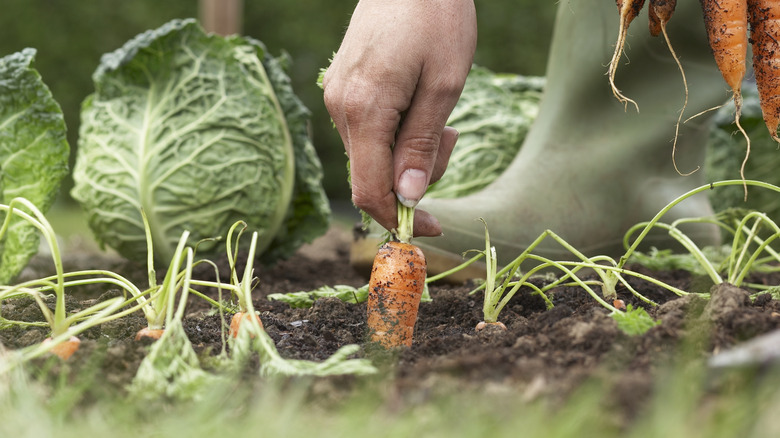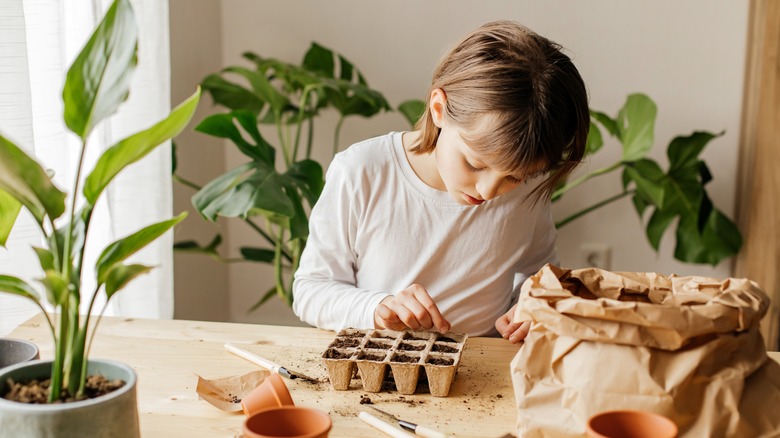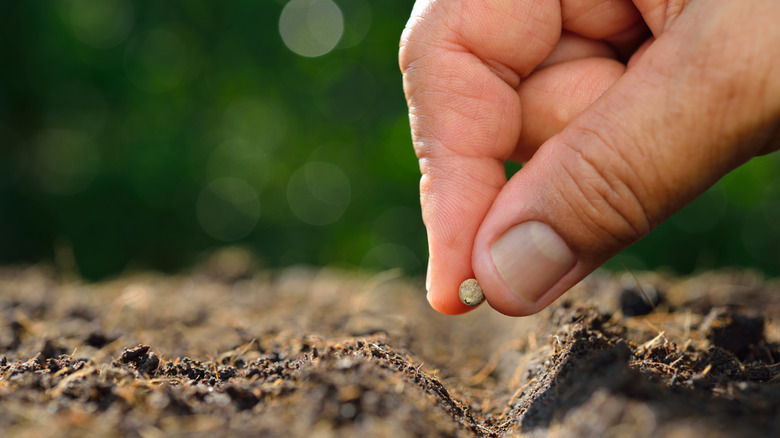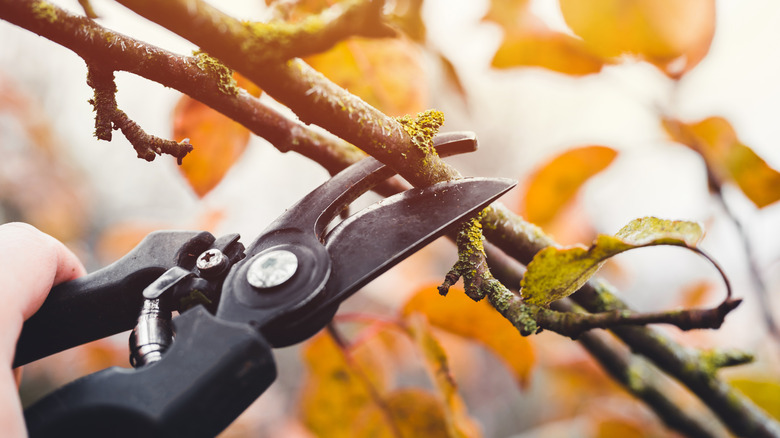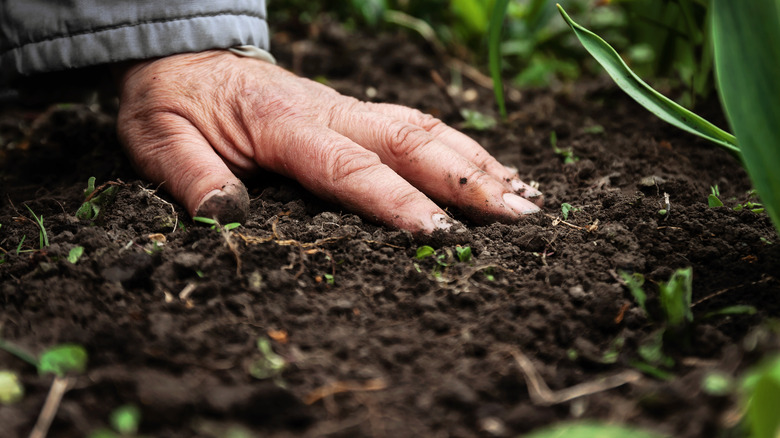Tasks To Do In February To Prepare For Your Best Spring Garden
It may seem like the gardening season begins when the days start to get warm and long again, but it really is a year-round process. Sure, some months are slower than others, but even in the midst of winter, there are tasks you can do to get a head start on the next season. A lot of winter gardening work is done indoors as you plan for the new season's garden, so there's no need to freeze outdoors in the dark after work to prepare for your best spring garden. With that in mind, it's nice to have a list of projects to do outside on those few gloriously warm afternoons as you count down the days to spring.
There are some tasks that can be done at any time. For example, Green Weaver Landscapes says winter is the best time to tackle the unpleasant task of removing invasive plant species from your yard. Since most plants are dormant during this time, you won't have to deal with all the leaves, making the unwelcome additions easier to handle. Here are a few more tasks you can do in February to prepare for a successful spring garden.
Plan your layout
Every gardener has heard the siren song of seeds calling out from shelves and catalogs, but before you buy, you need to know what you actually have room to plant. The same is true if you're buying seedlings. It would be frustrating to spend $50 on plants and return home to discover you only have room for half of them. Before heading to the nursery, make a list of the spring plants you want to grow, and plan exactly where they are going to go.
There are a few ways you can plan your garden. Grow Veg and other apps offer tools that take the guesswork out of how much space is required for each plant in your garden. If you prefer to work with pencil and paper, use graph paper to measure out your garden space with each square representing one square foot. For this process, you'll need to learn the proper spacing between each kind of plant. It's a way to work on your design skills while learning more about the needs of the plants you want to grow.
Start seeds indoors
If you're planning to start your own seeds indoors, you'll need to get to this task six to eight weeks before it will be time to transplant seedlings into the ground. The date you start seeds indoors depends on where you live. Spring vegetables like lettuce, cabbage, and onions can tolerate a light frost, so in most regions in the U.S., you can place these varieties outside in mid-March. That makes early February the best time to start these seeds indoors. If you're not sure when to plant, contact your local extension service. They can walk you through the process with specific information for your region.
Growing spring veggies can be a bit tricky because of the occasional hard freeze, which happens any time the temperature drops below 27 degrees Fahrenheit. It helps to know your USDA growing zone because that tells you the average last frost date in your area. Keep in mind, though, that the average date does not mean the last possible date. Some years the final freeze will be earlier and in others, it will be much later, so have a plan in place to protect your plants in the case of a late freeze.
Start seeds outdoors
Some seeds require stratification, which means they need to go through the natural harsh conditions provided by nature in order to sprout. This typically includes a period of cold, wet weather to break down their hard outer shell. There are different types of stratification, but for seeds intended for spring gardens, the process is referred to as moist stratification, explains Prairie Nursery. Many common wildflower seeds, such as coneflowers, milkweed, and primrose, require this process to germinate. To give wildflower seeds sufficient time to sprout, you can go outside in February and simply toss them in the area you want your wildflower garden to eventually bloom.
Although there is a bit of risk to it, you can also plant some frost-tolerant seeds in your garden in the hopes of a mild spring and early harvest. Since seeds are relatively inexpensive, it won't hurt to sprinkle a few on the surface of a section of prepared soil in your garden. Lettuce, carrots, dill, and radishes are inexpensive seeds that will germinate on the surface of the soil when the conditions are just right. And if they don't, you can try again when it warms up a bit.
Prune
In USDA hardiness zones 6 and warmer, mid-to-late February is the best time to prune some trees and bushes before they break dormancy. If you have fruit trees like apples, pears, or cherries, this is the time to remove any damaged or crossing limbs, as well as any branches that are hanging too low. The same rules apply to ornamental and wild fruit trees like crabapples. This is also the best time to prune roses and crepe myrtles. Those in zones 5 and cooler should wait until March or April to prune, and again, you can contact your local extension service for guidance. They'll let you know what, if anything, you can prune instead during February.
There are a few things to watch for as you're planning to prune. Never prune if you know there's a major cold snap expected in the next few weeks. Exposed cuts can weaken a plant and extremely low temperatures can cause further damage. Furthermore, never prune spring-blooming bushes like azaleas at this time of year, warns the Empress of Dirt. The general rule for pruning flowering bushes and trees is to wait until after they've bloomed.
Deal with winter weeds
Winter weeds can be frustrating to deal with in your garden beds. They seem to come out of nowhere overnight and take over, however, if you get an early start, you can prevent those weed seeds from germinating in the first place. As soon as your soil has thawed and can be worked, remove all existing weeds. Then spread a pre-emergent like Preen or another corn gluten meal-based product. There are organic and synthetic options available at most garden centers like Lowe's. If you live in an area where the ground does not freeze, this process should be done as soon as possible.
The key to using a pre-emergent is to apply it before weed seeds have sprouted. Pre-emergent products will not work on established plants or plants that are growing back from the roots. You will have to pull those by hand or apply an herbicide. Also, keep in mind that pre-emergents cannot distinguish between weed seeds and seeds you have intentionally planted, so do not use one of these products in beds where you've sown seeds. Pre-emergents can be safely used around established plants to continue to prevent weeds throughout the growing season.
